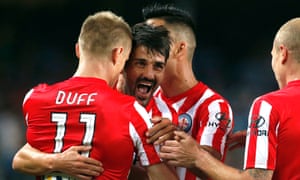Members of the Sierra Leone civil war amputees football team
Musa Mansaray was 10 when his home town of Kabala came under attack from rebel soldiers fighting to overthrow the government in Sierra Leone. “I had a close-range encounter with one of the rebels of the RUF [Revolutionary United Front] who asked me to stop and wait,” says Mansaray, now 22. “I was afraid, so I ran. He shot me in the leg and I dropped. I was lucky. Some of my friends were killed in the attack.”
The story is similar to thousands of others. The victims, due to lack of immediate medical attention, had to undergo the agonising ordeal of amputation, usually without anaesthetic.
Many more body parts – arms, legs, ears, fingers, lips, genitalia – when soldiers, some in their teens, were ordered to carry out crude, random amputations with machetes, axes and knives. A field worker for Human Rights Watch claims there were special RUF units devoted to cutting off hands, and that soldiers were promoted if they returned with a rice bag full of them.
According to European medical aid organisations working in West Africa about 3,000 people died as a result of wounds inflicted by amputations, and 1,600 amputees are still alive in Sierra Leone today, eight years after hostilities ended.
Mansaray is one of them, and remarkably, despite his disability he is having a good year that is about to get even better, thanks to his ability to play football on crutches. He has overcome the trauma of 1998 and is looking ahead with a positive attitude. He is disabled, he has no job – “that makes it difficult for me to find a partner” – and little money. But he is studying computer electronics and says, “I believe I shall succeed. My mother inspired me a lot. It is a test of your faith.”
A few weeks ago Mansaray travelled to Spain to play football, have a drink with his superstar idol David Villa and talk about the World Cup.
He is among a generation of footballers who are making headlines in Sierra Leone because they have been able to overcome their physical disadvantages on a football pitch. As a talented one-legged player he has represented Sierra Leone in many international events including World Cups in Turkey and Brazil. Sierra Leone also hosted the inaugural African Championship in 2007, thanks to a small sponsorship from Fifa. And in October he is off on his travels again – to the 2010 amputee World Cup in Argentina.
Not all the players in the one-legged teams in Sierra Leone and neighbouring Liberia are war victims; some are perpetrators. One of the most fascinating aspects of the amputee teams is the relationship between the former teenage rebels who took part in the two countries’ overlapping civil wars and the bystanders who were caught in the fighting.
In Liberia’s capital, Monrovia, Samuel Eastman, secretary general of the country’s amputee football association, who plays in midfield for the national team, says the team are a symbol of forgiveness.
Eastman lost his right leg in 1992. There had been an attack in a nearby village and he had run to help lift the wounded into a Red Cross jeep. Another explosion peppered his right leg with shrapnel. By the time Eastman was in a hospital the only thing doctors could do was amputate. “If we can come together, then the whole country can come together,” he says, gesturing to his team-mates.
Many of the amputees were shunned before they found success in football. Some still are in their daily lives, reduced to begging outside supermarkets. But playing football – and winning trophies – has helped to change perceptions. Every Saturday morning, Sierra Leone’s Lumley beach is filled with professional football teams conducting training sessions. But a space is always found for Mansaray and his team-mates.
Mansaray has added another “M” to his initials because his friends have nicknamed him Messi after the Argentina player. His favourite player is not Messi, though, but Villa, who has now joined Messi at Barcelona.
“When I was in Spain with the Sierra Leone side we met with the Spanish national team before they travelled to South Africa,” says Mansaray, who scored 11 goals in a series of friendlies. “They entertained us. I had a drink with my idol David Villa and we chatted about general issues. He said he is looking forward to meeting me again. We played a match of 20-minute halves with Xavi and Alonso, and it ended 0-0.”
On his return from Europe, Mansaray was delighted to hear that the United Nations secretary general, Ban Ki-moon, was coming to Sierra Leone and would be handing over a $100,000 (£66,000) cheque for the team, who have attracted other sponsorships too.
“The Sierra Leone government has already played its part by moving us into new homes, but this cheque will assist me and my colleagues for our tuition, food and clothing,” he says. “In fact, I can’t describe how happy I am.”











